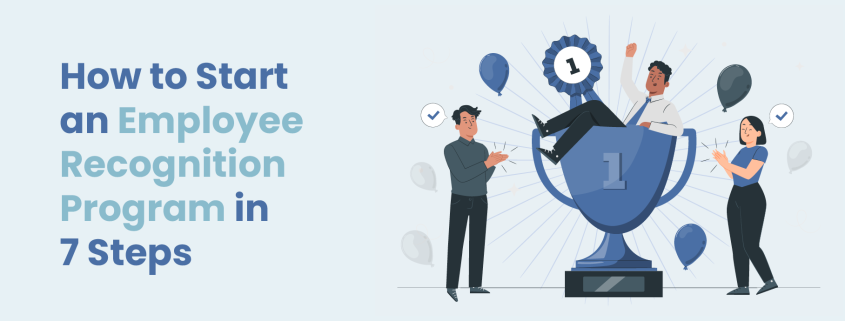How to Start an Employee Recognition Program in 7 Steps
Engaged employees produce high-quality work, are eager to share creative ideas, and stick around longer than their unengaged peers. However, only about 23% of employees report feeling engaged at work.
Despite so few employees being engaged, there are a few easy ways to raise these numbers. For instance, you can improve or implement an employee recognition strategy.
Employees who are recognized for their hard work are more likely to continue working hard in the future! This guide will walk you through launching an employee recognition program to help your business show appreciation for employees in more meaningful ways.
But first, let’s answer a few essential questions about employee recognition.
Employee Recognition FAQ
What is an employee recognition program?
Employee recognition can take many forms, but employee recognition programs can be summed up as structured methods for appreciating employees and acknowledging their accomplishments.
While you can and should still show informal recognition for your employees’ contributions, deliberate recognition programs ensure your entire team receives regular appreciation for their efforts.
Why does employee recognition matter?
Workplaces that have a strong company culture and high employee engagement rates also tend to have formal recognition programs. When your employees feel appreciated, they’re more likely to work hard, feel personally invested in their work, and speak positively about your workplace to prospective recruits.
Plus, employees who feel their efforts are recognized are more likely to be engaged. When it comes to employee engagement, the research speaks for itself about how its importance:

- 79% of employees will stay longer at a job where they feel supported and valued.
- Highly engaged business units increase profitability by 23%
- Replacing a lost worker costs roughly 20% of their salary.
- Engaged workforces see a 43% reduction in absenteeism.
Think of an employee recognition program as an investment in your business. Not only is appreciating employees the right thing to do, but it can also make your business more productive, profitable, and consistent.
What are the different types of employee recognition programs?
Before brainstorming appreciation ideas, consider the different types of recognition and how each fits into your business’s engagement strategy. These include:
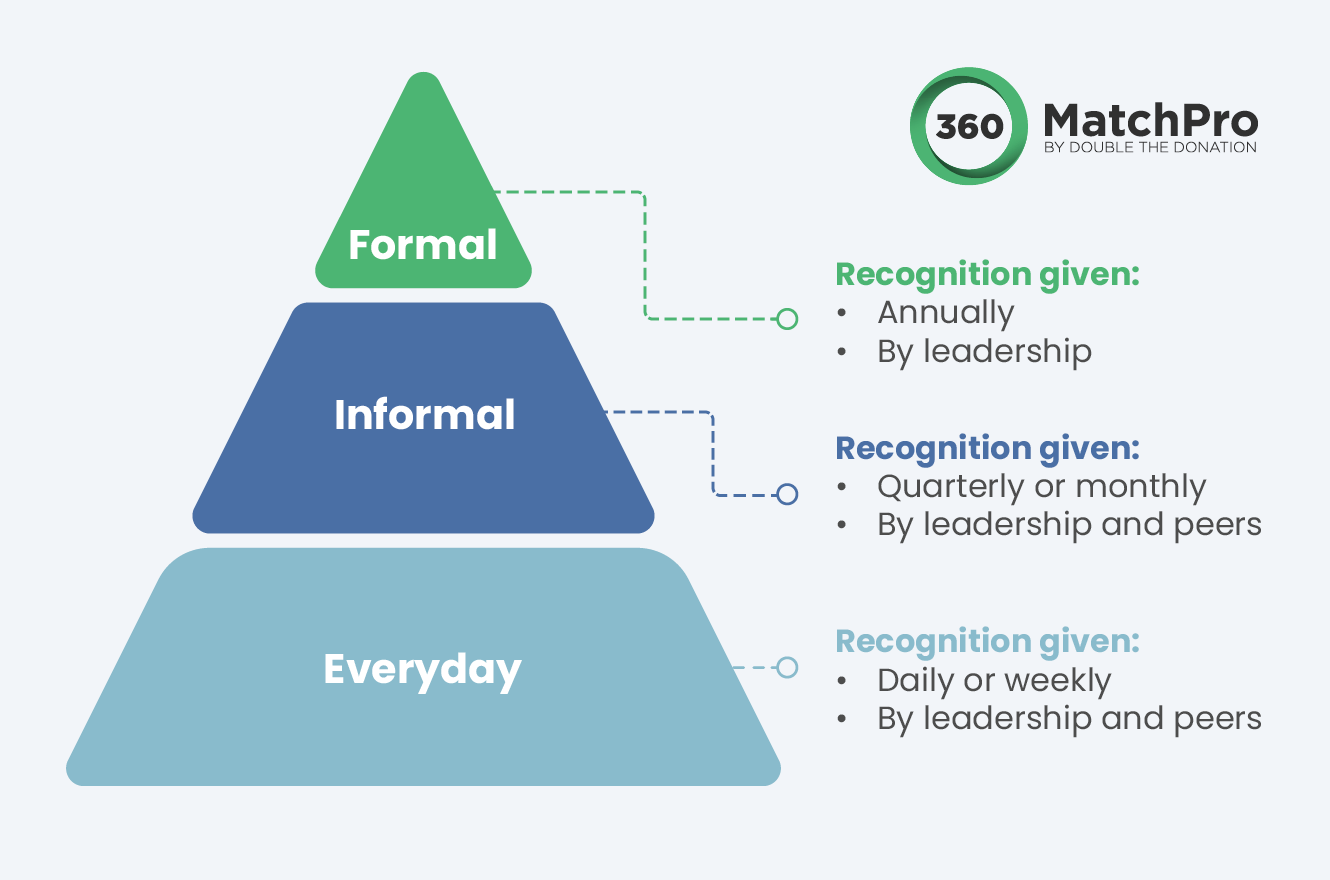
- Formal. Official recognition occurs during annual performance reviews and is given out by leadership. This type of recognition is meant to congratulate employees and provide insight into their compensation and promotion opportunities.
- Informal. Activities like appreciation events and employee of the month awards require structure and deliberate planning but are considered to be informal in comparison to the formal recognition that takes place during professional assessments.
- Everyday. Saying thank you when an employee leaves for the day, congratulating them on a job well done, and sending thank-you notes can all be done quickly and on a weekly basis. Unlike informal activities, there doesn’t need to be a purposeful structure behind everyday recognition.
Most employee recognition programs will be either informal or everyday recognition. While everyday appreciation requires less planning than informal recognition, some activities, such as sending eCards, still need initial setup and recognition software to function.
1. Establish your employee recognition program’s goals.
When planning an employee recognition program, your first step is to consider what you want the program to accomplish. While appreciation can be an abstract concept, your program should have concrete, measurable goals. For example, you might track:
- Employee participation
- Retention and turnover
- Absenteeism
- Productivity
Quantifiable changes in these metrics will inform you whether your appreciation program is successful.
For example, you might aim to reduce your turnover rate by 25% and aim to do so by creating a positive, supportive work environment. You would then implement a peer-to-peer recognition strategy to encourage co-workers to appreciate their fellow team members and build strong connections. After six months, you would then assess how your turnover rate changed since your recognition program’s implementation.
2. Choose your program type.
Every employee recognition program is unique, and you have a wide range of popular ideas to choose from when planning your business’s program. For instance, a few common employee recognition program ideas include:
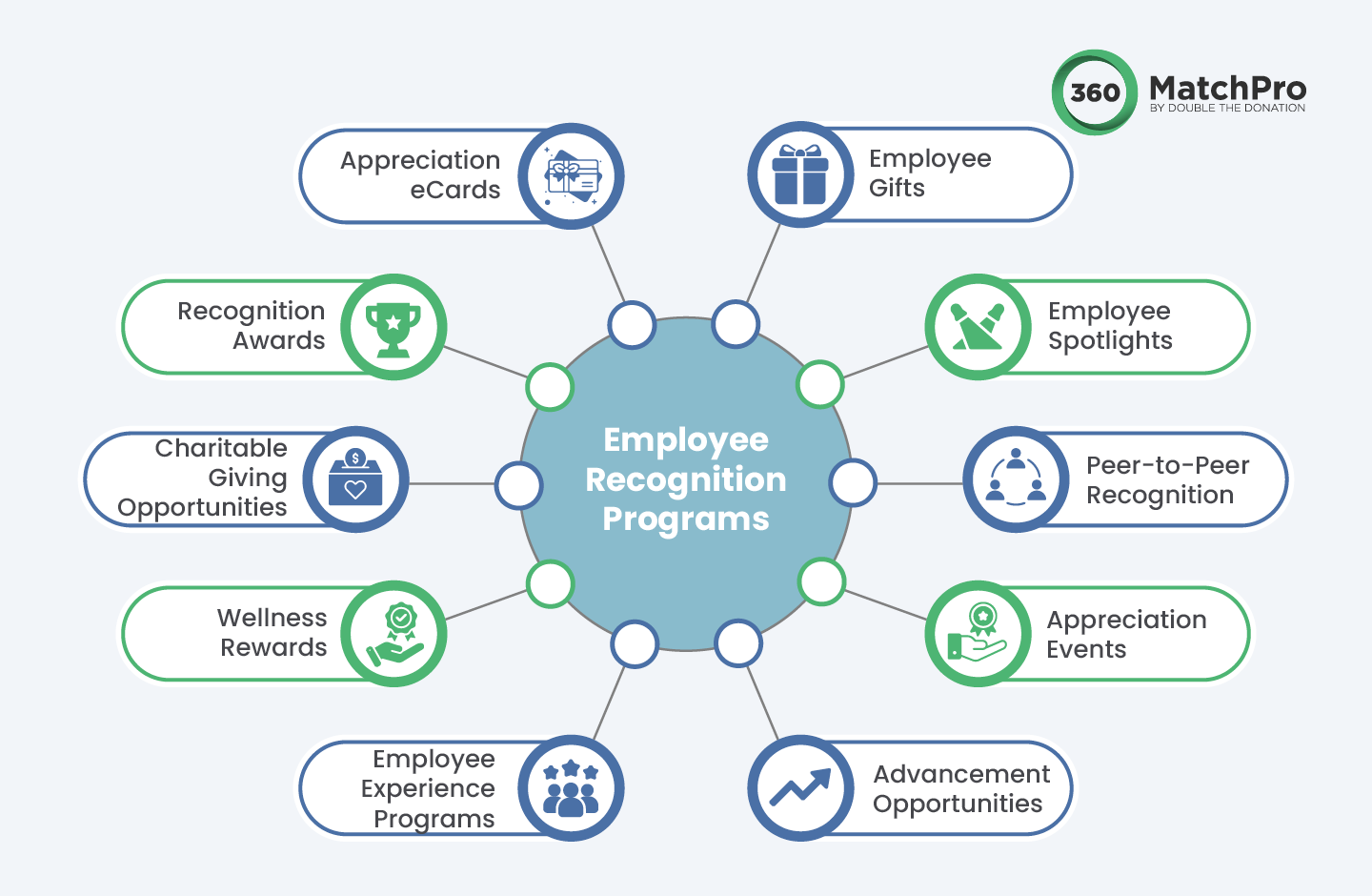
- Appreciation eCards. eCards are online greeting cards and are a fast and convenient but still meaningful way to recognize employees. Leadership or fellow employees can choose a pre-made eCard design and write a message explaining what the recipient is being recognized for.
- Employee gifts. Give employees small presents to thank them for being a part of your team. A few gift ideas include gift cards, branded merchandise, gift baskets, and lunches.
- Employee spotlights. Provide your employees with public recognition by acknowledging their efforts in front of the rest of your team or online. For example, you might make a LinkedIn post congratulating a team that just completed an important project.
- Peer-to-peer recognition. Appreciation from leadership can be incredibly meaningful, but your managers and senior staff can only see so much that happens every day. This means many of your employees’ accomplishments might go unnoticed. With a peer-to-peer recognition strategy, colleagues can appreciate each other, encouraging collaboration and cultivating a supportive environment where no one goes unrecognized.
- Appreciation events. Take your employees out to lunch, host an after-work get-together, or plan a holiday party to recognize your team’s accomplishments. These events give employees an opportunity to socialize, have fun, and feel appreciated in a more casual setting.
- Advancement opportunities. Reward high performers with the ability to move up the ladder. Provide motivated employees with the tools they need to improve their skills, such as offering to pay for professional development and certification courses. Not only will the employee feel recognized and supported, but your business will also cultivate a team of highly skilled workers.
- Employee experience programs. You can monitor how employees feel about their day-to-day work, identify points of frustration, and resolve issues with an employee experience program.
- Wellness rewards. Consider providing employees with rewards related to company goals, such as providing wellness-related goods for achieving quarterly goals. For example, you might buy a company subscription to a meditation app or compensate employees who buy exercise equipment. This provides employees with rewards and also encourages your team to improve their health.
- Charitable giving opportunities. Employees want to contribute to the causes they care about. Support their efforts with employee giving initiatives, like volunteer grants, matching gifts, and payroll giving.
- Recognition awards. Awards may be symbolic, but a trophy, certificate, or plaque can go a long way toward making an employee feel appreciated.
When selecting your employee recognition program, remember there’s no need to stick to just one type of program. For example, you might offer employees matching gifts and host routine appreciation events.
Choose whichever program, or combination of programs, most interests your team.
3. Determine your employee recognition program’s budget.
Some employee recognition activities require spending. For example, most appreciation software platforms have subscription fees, and buying routine gifts can add up.
Create a budget by determining how much you will spend on employee recognition per employee per year or per activity. For instance, you might have a price ceiling of $50 for company gifts or take employees out to lunch but only reimburse them for up to $25.
While appreciation costs money, understand that in return, your business will receive a more productive and loyal workforce, helping your organization increase profitability and reduce turnover costs.
4. Invest in the necessary software.
Many employee appreciation programs require software. For instance, employee experience programs need surveys and analytics tools, and employee giving programs need CSR software to function.
One employee recognition program our company has found success with is eCards. eCards are digital greeting cards, and an eCard platform can turn this appreciation activity into a unifying peer-to-peer recognition strategy.
Here’s how you can use eCard software to recognize employees:
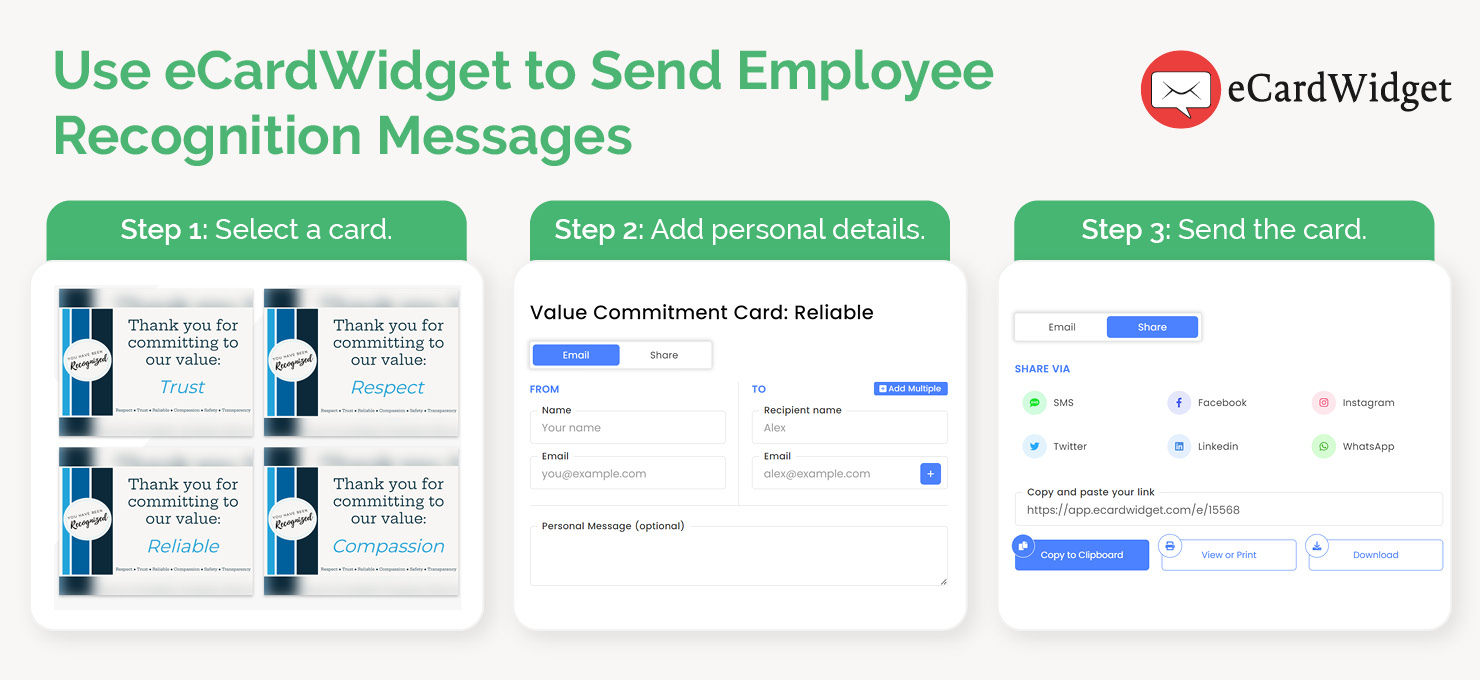
- Select an appreciation eCard. Use your eCard software to design custom eCards. Choose a platform that has templates, graphics, customizable colors, and plenty of fonts to create your eCards. Your platform may even allow you to upload custom assets to create wholly original cards that reflect your company’s brand and values. Employees who want to show appreciation for their colleagues can then log in to your platform and select one of these pre-created eCards.
- Add a message. eCard images and illustrations grab your employees’ attention, but the message inside is often what matters most. Encourage employees to provide details about the specific actions they want to recognize to ensure each eCard is meaningful.
- Send the eCard. Once they’ve written their message, employees can send their eCards. Look for an eCard platform that allows for multiple recipients, so your leadership can stay informed about who is being appreciated and why.
When it comes to eCard platforms, we highly recommend eCardWidget. This flexible platform allows companies to recognize employees easily and use eCards to support other areas of their business. For instance, companies can leverage eCardWidget to also create customer appreciation cards, product promotions, event invitations, and holiday cards.
5. Create an employee recognition structure.
As discussed, everyday appreciation can happen casually and without deliberate planning. However, adding structure to your program will help employees better understand why they are being recognized and what that recognition means.
A few questions to ask about your employee recognition program include:
- Which employees will be recognized? Consider what types of actions should receive recognition. For example, you might tie recognition to your company’s values, revenue generation, or some other metric. Remember, when you recognize employees for specific behaviors, you will reinforce those behaviors. While this can lead to a productive workplace, it may also stoke friendly competition among your workforce.
- How will employees be recognized? Outside of specific recognition activities, do you plan to make recognition a private or public event? For instance, you might direct managers to send eCards to employees they see going above and beyond, or you might give out awards at an all-hands meeting in front of your entire team.
- When will recognition take place? While quick thank-yous in the moment are always a good idea, you should also consider how soon to recognize an action after it takes place. For example, you might send thank-you notes later that same day or wait until a designated recognition day, such as at the end of the quarter.
For one example, let’s take a look at employee recognition right here at Double the Donation!
Our team takes a peer-to-peer approach to sending eCards, encouraging colleagues and managers alike to show their appreciation whenever they notice someone going above and beyond.
Then, to show our recognized employees extra appreciation, we gather eCards sent throughout the month and display them in all-hands meetings through what we call the Bravo Board!
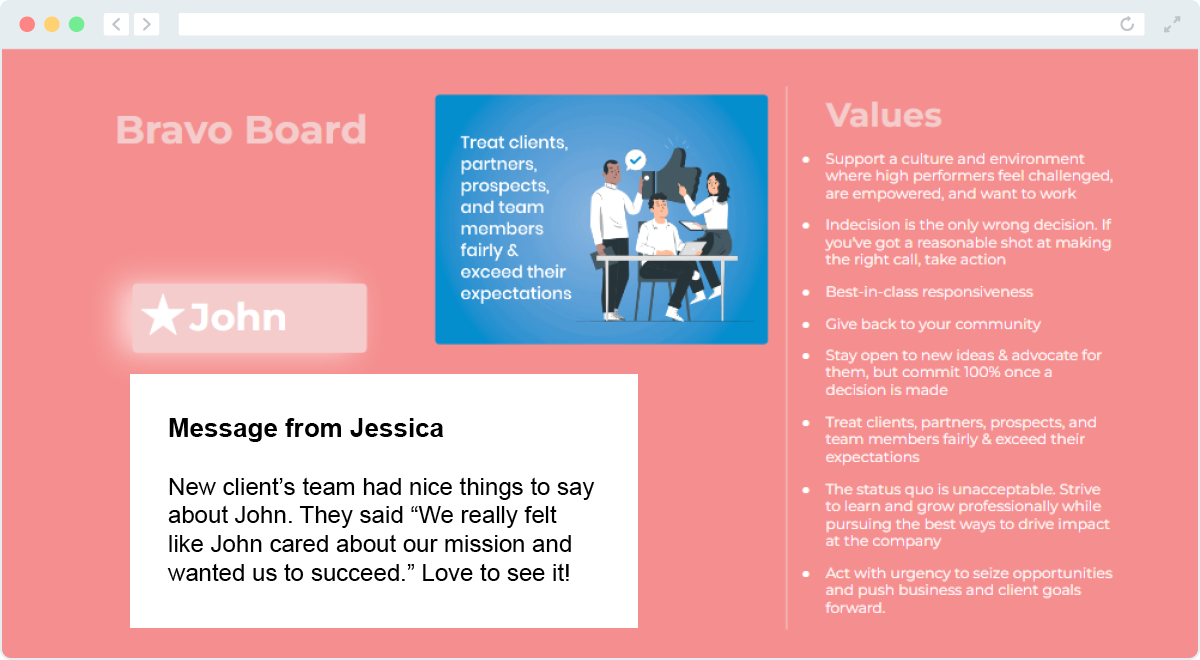
Each Bravo features the message from the eCard that was sent and the company values the recipient embodied. This approach ensures that employees are appreciated in the moment, public recognition is a part of company culture, and our company values are reinforced with the whole team.
6. Encourage participation in your employee recognition program.
Some employee recognition programs, such as gifts and awards, require minimal active participation from employees. Others, like peer-to-peer initiatives and employee giving programs, require your leadership to actively motivate employees to get involved.
While some employees will voluntarily participate in your recognition efforts without prompting, others will need encouragement, especially when your program is first launched. Engage employees and create buy-in by:
- Having leadership participate
- Hosting in-office activities
- Recognizing individuals who actively participate
If you notice low participation rates, seek employee feedback. While recognition programs are meant to benefit employees, different teams will prefer different types of appreciation activities.
7. Track results.
After implementing your employee recognition program, track employee participation, employee retention rate, productivity, and other relevant metrics to gauge its effectiveness.
If your recognition strategy involves engagement software, you can leverage it to measure employee participation. For example, you might use your CSR software to monitor how many employees sign up for volunteer opportunities or submit a matching gift request.
Additionally, gather employee feedback. Send out anonymous surveys or have managers ask their directs to share their thoughts on your recognition programs. This can provide insight into what employees like about your recognition program, why they participate in certain activities, and what could be adjusted to better engage your team.
More Employee Engagement Resources
When employees are recognized for their efforts, they’re more likely to engage with their work, helping your business cultivate a team of motivated, productive, and loyal employees. To implement a recognition program, talk with your employees about how they would prefer to be acknowledged, invest in the needed software, and establish a structure for your program.
For more information on how to engage your employees, try these resources:
- An Eye-Opening Look at Volunteer Time Off Programs. Volunteer time off programs allow employees to give back without worrying about work commitments. Learn what volunteer programs are and why they’re so in demand.
- How to Start a Matching Gift Program in 3 Easy Steps. Matching gift programs empower your company to make a positive impact alongside your team. Discover how you can launch a matching gift program in just a few steps.
- What Is Payroll Giving? How to Make Donating More Efficient. Payroll giving is one of the easiest employee engagement programs. Learn how to get started with this offering.

